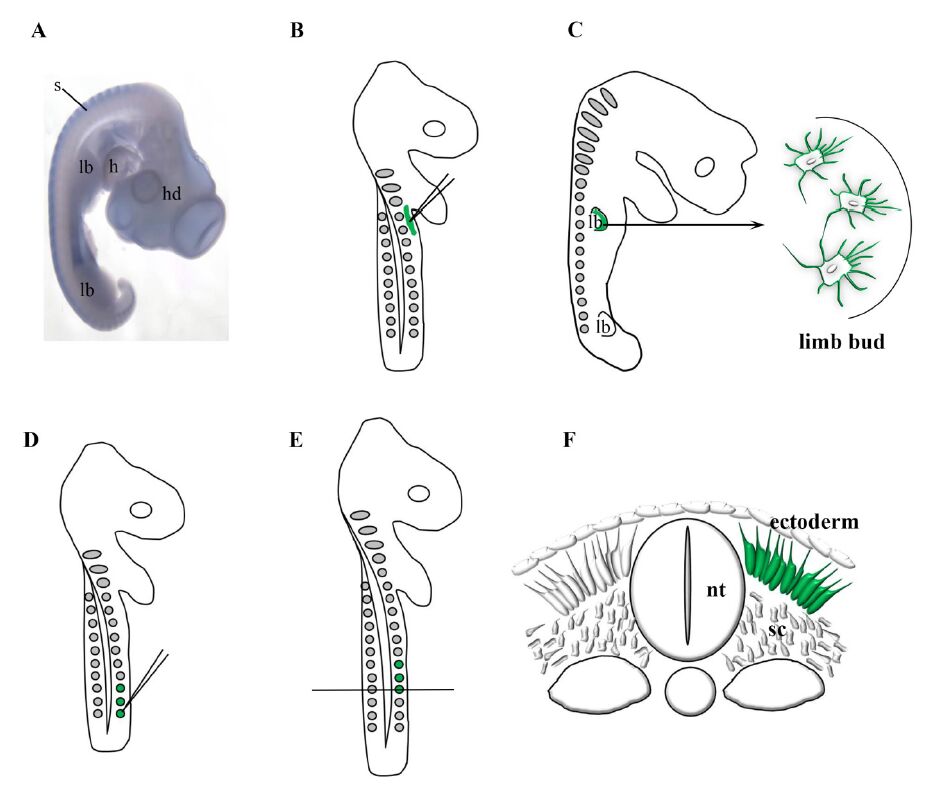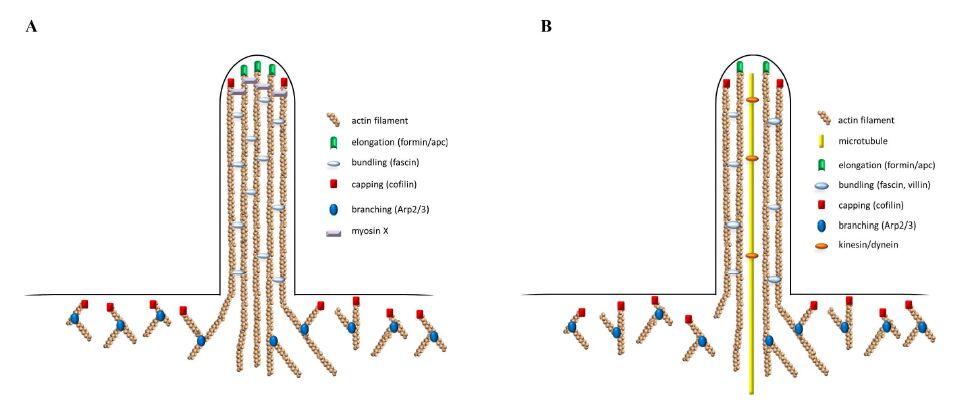1. Introduction
The development of multicellular organisms is stringently controlled by the interaction of multiple proteins that regulate intracellular signaling cascades as well as intercellular communication. According to the composition and concentration of signaling proteins cells obtain developmental information corresponding to which they proliferate, differentiate or move to form tissues and organs. Signaling molecules are chemokines, growth factors or extracellular matrix (ECM) molecules. Some signaling molecules diffuse over long distances while others are hydrophobic and remain close to the secreting cell. In the classical morphogen model signaling molecules diffuse to build up concentration gradients which determine the fate of the recipient cells. Recent studies have established that also non-diffusible signaling molecules can be transmitted over considerable distances along cellular protrusions extending from one cell to the other.
Initial evidence for long range cell-to-cell contact ranges back to Gustafson and Wolpert (1967), who described long thin filopodia during sea urchin gastrulation, where they connect primary mesenchymal cells with ectodermal cells across the blastocoelic cavity [1,2]. In Drosophila, long thin cellular extensions, termed cytonemes, were described in epithelial cells of wing imaginal discs and discussed to play a role in intercellular signal transduction [3], a hypothesis that was confirmed later [4]. Ever since, and due to improved life imaging techniques, many studies in a number of different organisms showed that cellular protrusions are involved in the distribution of morphogens from cell to cell, either sending or receiving signaling molecules [5,6].
2. Signaling filopodia in chicken embryogenesis
In the chicken embryo a network of signaling filopodia emerging from mesenchymal cells was observed by life cell imaging in limb bud cells that express membrane tethered fluorescent proteins (Figure 1A and B) [7]. These protrusions, which the authors named specialized filopodia, cannot be fixed with formaldehyde and can only be visualized with fluorescent membrane markers. Specialized filopodia are very dynamic, elongate and retract to follow guidance cues. They reach up to 150 µm with an average length of 34.27 ± 9.6 µm and a diameter of 200 nm. They can be labeled with the actin associated proteins cofilin and fascin, which are required for stabilizing and bundling of actin filaments (Figure 2A). Additionally, expression of a fluorescent myosin X protein, a plus end actin motor protein, is localized at the tip of the filopodia (Figure 2A). Markers of the microtubule network, like microtubule-associated proteins TAU and EB3 are found at the proximal base of the filopodia but not along their whole length [7].
The morphogen Sonic Hedgehog (Shh), which is involved in many developmental processes, controls the specification of digits in the limb bud [8]. In contrast to the classical diffusion-based model, Shh has been shown to be transported net anterogradely along these signaling filopodia in the limb mesenchyme [7]. Interestingly, not all mesenchymal filopodia are Shh positive, indicating that the loading of filopodia with receptor or morphogen is specifically controlled. Furthermore, the dynamics of filopodia motility varies according to their loaded carriage: filopodia containing Shh particles are stabilized and less dynamic than non-particle-containing filopodia [7]. However, not only the Shh ligand, but also co-receptors of Shh have been shown to be transported along mesenchymal filopodia [7].
Another type of signaling filopodia in chicken was described in the subectodermal space overlying the dorsal surface of the somites (Figure 1C and D). These filopodia are called filopodia like protrusions (FiLiPs) and contain actin, the actin associated proteins cofilin and fascin, and also microtubule elements. They are formed at the basal side of polarized epithelial cells of early and matured somites, i.e. the dermomyotomal cells. FiLiPs penetrate the basement membrane and contact the overlying ectoderm. Two types of somitic filopodia have been found: stable filopodia, which form contacts with the ectodermal cells lasting for several minutes, and dynamic filopodia that extend rapidly in all directions as if searching for signaling cues. Both types have diameters between 200-500 nm, and in contrast to the specialized filopodia in chicken limb buds, they can be preserved by formaldehyde fixation [9]. It was shown that the Wnt receptor frizzled 7 (Fzd7) is transported retrogradely along the FiLiPs. Accordingly, it can be assumed that these FiLiPs may transport the activated receptor or receptor bound morphogen, presumably a member of the Wnt family, from the tip of the filopodium to the cell body [9]. Interestingly, in Xenopus not the Wnt receptor, but the ligand Wnt2b-EGFP moves along filopodia [10] illustrating that in the same signaling pathway either the receptor or ligand can be transported along signaling filopodia in different developmental settings.
3. Cytoskeletal dynamics during formation of signaling filopodia
The formation of cellular protrusions like signaling filopodia involves cytoskeletal reorganization which requires a dynamic network of actin and microtubule filaments.
Actin is a key structure of the cytoskeleton and is formed by polymerization of globular actin (G-actin) to filamentous actin (F-actin). Actin filaments are polarized with a fast-growing barbed or plus end and a slow-growing pointed or minus end [11]. During actin polymerization different stages can be discriminated such as nucleation, elongation, branching, bundling, and termination, which are tightly regulated by a number of actin associated proteins.
The initiation of actin-filament assembly, a process termed nucleation, requires the formation of a nucleus consisting of a trimeric complex of actin molecules. Nucleation is regulated by nucleation promoting factors, which are mainly members of the WASP/Scar protein family [12]. Nucleation and elongation of actin filaments is controlled by proteins of the formin family [13,14,15], such as diaphanous-2 (Dia2) [16]. The elongation of actin filaments continues rapidly until capping proteins like cofilin terminate the elongation process by binding and stabilizing the barbed ends. Furthermore, the severing function of cofilin, which generates barbed ends, allows a quick restart of polymerization [17]. Expression of a fluorescent cofilin protein localizes to both the FiLiPs in the somites as well as the filopodia in limb buds (Figure 2A and B) [7,9].
The formation of filopodia requires the bundling of actin filaments by so called bundling proteins. The parallel packed filaments push the membrane forward resulting in finger like protrusions. The master actin-bundling protein is fascin [18,19]. Fascin compacts 10-30 actin filaments to form a filopodium with a diameter between 60-200 nm [20]. RNA interference experiments show that downregulation of fascin reduces the number of filopodia [21]. Interestingly, elevated levels of fascin are found in metastatic tumors and fascin is a putative novel target for anti-cancer drug development [22].
Both, the filopodia of the limb bud as well as the FiLiPs in the somites, show expression of a fascin-EGFP fusion protein (Figure 2A and B) [7,9]. Other bundling proteins also play major roles in actin filament bundling. Especially in epithelial cells, the actin bundling protein villin is required for filopodia formation by directly binding to phospholipids in the membrane and mediating nucleation, capping and bundling of actin filaments [23,24]. A role of villin in FiLiPs formation in chicken embryos has not been investigated so far.
Myosins areactin binding motor proteins that have filopodia inducing activity and localize to the filopodial tips [25]. One group of myosins, myosin X, is able to bind several molecules, like phosphoinositides, microtubules and integrins. Myosin X moves along actin filaments to transport molecules within the filopodium [25]. Myosin X-EGFP was found at the tips of specialized filopodia in chicken limb buds (Figure 2A) [7], its expression was not investigated in somitic FiLiPs [9].
Microtubules are required for many cell movements, like intracellular transport, separation of chromosomes and the beating of cilia and flagella. Microtubules are assembled from dimers of α- and β-tubulin. Like actin filaments microtubules elongate by polymerization; they have a minus end which is directed towards the cell body and a plus end towards the periphery of the cell [26]. The formation of the rapidly growing microtubules requires an initial nucleation event occurring at the centrosome in the microtubule-organizing center (MTOC) [26]. In axons cell organelles, protein complexes and mRNAs are transported along the microtubules via the motor proteins kinesin in plus end direction and dynein in minus end direction [27].
In epithelial FiLiPs the presence of microtubules is indicated by the localization of tubulin, kinesin and dynein (Figure 2B) [9]. The microtubule-associated EB proteins induce changes in the structure of microtubules and promote their growth by binding to the growing end [26]. As EB3 protein is limited to the base of the mesenchymal limb bud filopodia, it appears that the mesenchymal limb bud filopodia are devoid of microtubules [7], as are the cytonemes in Drosophila [3].
Filopodia containingboth, actin filaments and microtubules are also found in junctional extensions in mouse blastocysts and cardiac progenitor cells in the mouse embryo [28,29]. Interestingly, similar to the chicken dermomyotomal cell layer, murine cardiac progenitor cells form an epithelial sheet with polarized cells. Filopodia formed by these polarized cells extend from their basal side to contact the overlying mesenchyme and pharyngeal endoderm [28]. Yet, actin and microtubule positive filopodia were also detected in non-epithelial cells as in cultured mesenchymal mouse cells [30], in cultured fibroblasts of Xenopus embryos [10], and also in axons of neuronal cells, which have the ability to innervate multiple target cells by means of filopodia. These filopodia are actin-filament-based and become invaded by microtubules during maturation. Here microtubules stabilize the cytoskeleton of these extensions and allow rapid cargo transport [31].
It is unclear why some signaling filopodia contain both actin and microtubule filaments, whereas others contain actin filaments only. Actin filaments are sufficient to induce filopodia formation, regulate cell migration and intracellular transport. So what are microtubules needed for? In neurons, the co-existence of actin and microtubule filaments is essential for their function and disruption of either type of filaments results in neurodegenerative disorders [32]. One possible model is that actin and microtubule transport counteract each other to distribute particles, organelles or molecules evenly in the cell including the filopodium [33].
The architecturalorganization of the actin and microtubular cytoskeleton within the dermomyotomal filopodia has not been investigated yet. We hypothesize that microtubules are located in the center of the filopodia (Figure 2) thereby stabilizing them and possibly controlling the anterograde transport of the Wnt receptor Fzd7 to the tip of the filopodium. Binding of the Wnt ligand requires the peripheral localization of the receptor, and subsequent retrograde transport of the Wnt/Fzd complex could then be actin based. So the different cytoskeletal components could be required for different transport mechanisms.
Another possibility is that not all filopodia are equipped with actin filaments and microtubules, but that the composition of cytoskeletal elements varies according to the cargo being transported. This idea is based on the finding that cytonemes in Drosophila are used selectively to transport only one type of ligand or receptor [34].
Rho GTPases: The reorganization of the cytoskeleton and the dynamics of actin and microtubule polymerization are predominantly regulated by Rho GTPases, which belong to the Ras superfamily of small GTPases. Rho, Rac and CDC42 are highly conserved and have been investigated most thoroughly [35,36,37,38,39,40]. They regulate actin-cytoskeleton dynamics in all eukaryotic cells. The activities of Rho GTPases are strictly controlled and switch between an inactive GDP bound state and an active GTP bound state [41] which is regulated by guanine nucleotide exchange factors (GEF), GTPase activating proteins (GAP) and guanine nucleotide-dissociation inhibitors (GDI). The activation of Rho GTPases is regulated by phosphoinositides [42], by activated growth factor receptors such as in Wnt signaling [43,44], or other receptor tyrosine kinases (RTK) [45].
Many filopodia andcytonemes transport growth factors or the respective receptors to target cells to activate Rho GTPases and thus the signaling pathways, which eventually result in actin cytoskeleton rearrangements and cell movements during development. Different Rho GTPases seem to be involved in the induction of filopodia formation in different tissues and organisms. The expression of dominant negative Rac (dnRac) in the somites of chicken inhibits FiLiP formation, indicating that Rac is essential for their development [9]. RhoD was shown to be required for filopodia formation of cytoneme-like protrusions in cultured embryonic mouse cells [30]. The Rho GTPase CDC42 is necessary for the formation of Wnt8a carrying filopodia in zebrafish embryo [46], yet its inactivation did not seem to affect filopodia formation in the chicken limb bud [7].
4. Conclusions
Cellular protrusions like filopodia and cytonemes play important roles in many developmental processes. They are not only required for cell adhesion and cell migration but also for cell-cell signaling that activates different signaling cascades. Recent work has identified two different types of signaling filopodia in mesenchymal and epithelial cells of the developing chicken embryo, which might serve as models to further study filopodia-mediated signaling events during embryogenesis.
A number of principles have emerged from these studies. Initiation of cellular protrusions is achieved at spots where actin filaments are bundled and elongate. Some of these protrusions contain microtubules. Induction of these cytoskeletal rearrangements is controlled by extracellular matrix molecules or growth factors bound to their respective receptors at the plasma membrane. Dynamic filopodia search their environment in all directions until they find their guidance cues like Wnt ligands or their receptors on the neighbouring cells. Stable filopodia are formed connecting to the matching receptor or ligand. Receptors or their ligands are transported to the target cells along these filopodia to activate a signaling cascade which leads to formation of more filopodia and to the induction of cell differentiation and/or cell movement. In spite of much progress in recent years, many aspects of signaling filopodia formation and function are still obscure. The chicken embryo may serve as a suitable system to further study filopodia-dependent signaling both in mesenchymal and epithelial cells during vertebrate development.
Acknowledgments
We would like to apologize to the authors whose work we could not mention in this review for reasons of space.
Conflict of interest
There is no conflict of interest.










 DownLoad:
DownLoad: 


